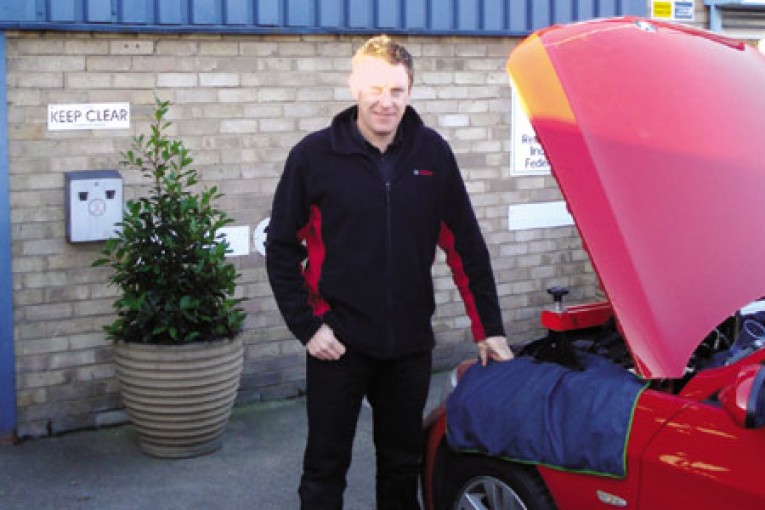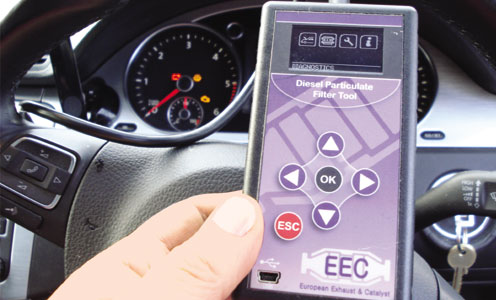
With DPF checks now included in the MOT inspection, complete component removals could result in a failed test and a subsequent invalid motor insurance claim.
European emission legislation is becoming progressively more stringent with regard to the level of emissions that vehicles are permitted to emit. VMs are under pressure from governments to totally eliminate harmful emissions.
A good example of this is shown in the fact that Euro 6 diesel emissions systems require the exhaust gases to pass through four separate filters/cats:. Oxicat, DPF, Diffuser, and SCR (Selective Catalytic Reduction).

The role of the DPF
The DPFs that are currently fitted to the majority of diesel vehicles are basically just a filter for the collection and disposal of sooty particles or particulate matter (PM). In a perfect combustion, carbon dioxide, water and nitrogen are the end products. In reality, the incomplete combustion of diesel fuel results in emissions that include oxides of nitrogen (NOx), carbon monoxide (CO), carbon dioxide (CO2), water (H2O) and unburned hydrocarbons (HC). There are also un-burnt carbon particles, as well as engine oils, debris, soot and ash particulates, which are known as particulate matter (PM). This particulate matter (PM) can be categorised into two groups:
1. Particles of 2.5 microns to 10 microns;
2. Particles of less than 2.5 microns in size.
Although most diesel particulates are very small, more than 99% are in the sub-2.5 microns category. All are damaging to your health, as they are carcinogenic. Wall-flow diesel particulate filters usually remove 85% or more of the soot and can at times (in heavily loaded conditions) attain soot removal efficiencies close to 100%.
The DPF is a filter designed to collect PM, so if extra PM is produced it will be the result of a problem upstream of the DPF. Faulty components that can generate high levels of PM include: fuel injectors, glow plugs, incorrect oil, contaminated oil, turbos, EGR valves and air filters. For diesel powered vehicles with active DPFs (from 2006) it is extremely important that
the correct grade of engine oil is used as recommended by the manufacturer. The oil should also be checked for contamination. Failure to do so could result in an expensive repair bill for a new DPF and/or a new turbo. In addition to collecting the particulate, a method must exist to clean the filter.
Regeneration time
When the DPF reaches a pre-determined PM fill level (around 40%) the ECU will activate the regeneration process. This can inject fuel up to eight times per stroke to produce temperatures in excess of 550˚, which will burn off the PM that has been captured within the DPF.
Forcing a regeneration
In order to carry out a ‘forced’ DPF regeneration the correct diagnostic/reset tool must be used. Tools, such as the DPF reset unit from EEC, have been designed to perform this operation, with the procedure taking up to 30 minutes to complete.
Regular maintenance required

Filters require more maintenance than catalytic converters. Engine oil ash builds up on the surface of the inlet face of the filter, and will eventually clog the pores. This increases the pressure drop over the filter which, when it reaches a totally clogged state, is capable of causing engine damage. Regular filter maintenance is therefore a necessity.
If the DPF is not regenerated and fills to over 90% or 45g, the component will need replacing. This is not covered under warranty. When fitting a new DPF, the ECU must be reset and then a forced regeneration activated – this is to ensure that the ECU knows that the DPF and all related sensors are reset to empty.
EEC’s offering
European Exhausts & Catalysts (EEC) is committed to an education and training programme to help technicians understand, evaluate and diagnose emission problems. The company has an increasing, extensive range of DPFs and has invested heavily in its own wash coating facility in Denmead.
WHY MIGHT THE DPF FAIL TO REGENERATE?
■ The engine management light is illuminated for any fault.
■ If there is less than 20 litres of fuel in the fuel tank or if the fuel light is on.
■ Pressure sensors. Check these as there could be a build-up of water.
■ Pressure pipes could be damaged. These should be examined and must be clean and dry.
■ The EGR system isn’t working correctly.
■ The wrong spec engine oil has been used in the vehicle.
■ Engine oil has suffered diesel contamination (possibly as a result of regeneration).
■ Check the fuel additive (active system) Eolys.









